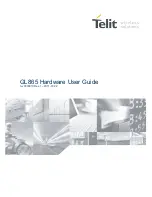
www.ti.com
8.3.3 Vector Table Entry Address Generation
Return from INT
Branch to INT
Branch to INT1
Branch to INT63
EABASE
(1*SIZE)
(2*SIZE)
(64*SIZE)
Address
Interrupt entry table
8.3.4 Clearing Interrupts
INTC Methodology
To help speed up the ISR, the AINTC provides two vectors into the ARM’s interrupt entry table, which
correspond to the highest priority effective IRQ and FIQ interrupts. This vector is generated by modifying a
base address with a priority index. The priority index takes the size of each interrupt entry into account
using the following formulas:
IRQENTRY = ((highest priority IRQ EVT# + 1) * SIZE)
FIQENTRY = ((highest priority FIQ EVT# + 1) * SIZE)
The EABASE base address is contained in a register. The SIZE value is a programmable register field,
which selects 4, 8, 16, or 32 bytes for each interrupt table entry. The IRQENTRY or FIQENTRY register is
read by the ARM, depending on which type of interrupt it is servicing. The ARM interrupt entry table format
is shown in
Figure 8-2. Interrupt Entry Table
The highest priority effective IRQ or FIQ interrupt includes only those interrupts that are enabled by their
corresponding EINT bit by default. However, the IERAW and FERAW register bits, if set, allow the highest
priority event of any of those captured in the IRQ or FIQ register to be used in calculating IRQENTRY and
FIQENTRY, respectively (regardless of the EINT state).
The IRQENTRY and FIQENTRY values are generated in real time as the interrupt events occur. Thus,
their values may change from the time that the IRQ or FIQ is sent to the ARM to the time the ARM reads
the register. They may also change immediately after a read by the ARM if a higher priority event occurs.
If no IRQ mapped effective interrupt is pending, then the IRQENTRY value reflects the EABASE value.
Similarly, if no FIQ mapped effective interrupt is pending, then the FIQENTRY value reflects the EABASE
value.
1. For the FIQENTRY:
•
If FERAW is 0, FIQENTRY reflects the state of the highest priority pending enabled FIQ interrupt. If
the active FIQ interrupt is cleared in FIQn, then FIQENTRY is immediately updated with the vector
of the next highest priority pending enabled FIQ interrupt.
•
If FERAW is 1, FIQENTRY reflects the state of the highest priority pending FIQ interrupt (enabled
or not). If the active FIQ interrupt is cleared in FIQn, then FIQENTRY is immediately updated with
the vector of the next highest priority pending interrupt (enabled or not).
2. For the IRQENTRY:
•
If IERAW is 0, IRQENTRY reflects the state of the highest priority pending enabled IRQ interrupt. If
the active IRQ interrupt is cleared in IRQn, then IRQENTRY is immediately updated with the vector
of the next highest priority pending enabled IRQ interrupt.
•
If IERAW is 1, IRQENTRY reflects the state of the highest priority pending IRQ interrupt (enabled
or not). If the active IRQ interrupt is cleared in IRQn, then IRQENTRY is immediately updated with
the vector of the next highest priority pending IRQ interrupt (enabled or not).
Events cause their matching bit in the FIQ or IRQ register (depending on the event priority) to be cleared
to 0. An event is cleared by writing a 1 to the corresponding bit in the FIQ or IRQ register. Writing a 1 to
the corresponding bit sets the bit back to a 1. Writing a 0 to an event bit does not affect its value.
SPRUFB3 – September 2007
Interrupt Controller
91
















































